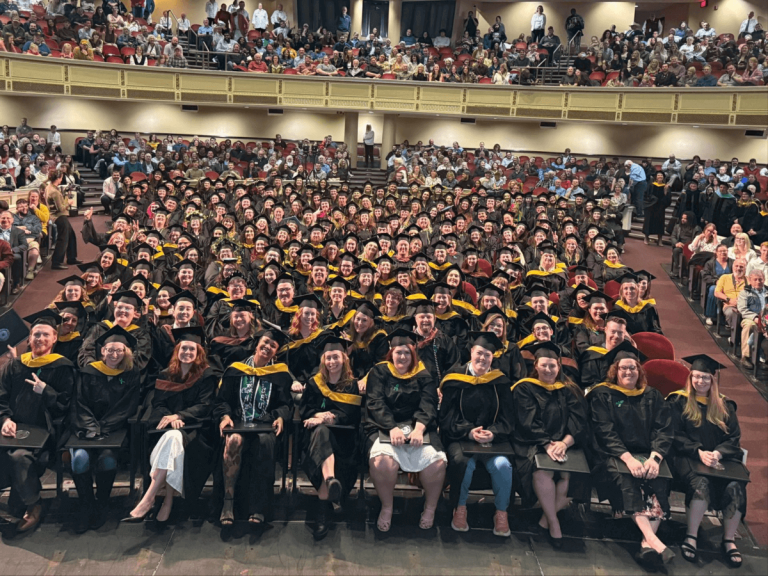
“You will, for the first time, know and understand how Unity College came to be.”
– Bert Clifford, introduction to “Ordinary, Yet Extraordinary: Six Decades in the Life of Unity, Maine 1941-2001” by Dorothy E. Freeman, PhD and Susan M. Simeone
An article published in the magazine Dirigo in 1969 recalls a prevailing fear of rural decay that helped lead to the founding of the college.
College founder Bert Clifford saw a town “flanked by fertile farms, and several small businesses flourished.” However, as Dr. Dorothy E. Freeman and Susan M. Simeone write in “Ordinary, Yet Extraordinary: Six Decades in the Life of Unity, Maine 1941-2001,” the definitive history of the town, “Mr. Clifford was haunted by those almost deserted villages and fields choked with alders, and he could not forget that even Unity had lost its canning factory, its hotel and its creamery.”
So it was that “decline did not come to Unity,” Freeman and Simeone wrote. “Instead, it experienced a renaissance.”
Some accounts claim the founding stemmed from the Unity being left off road maps or, alternately, from the state’s failure to route the Maine Turnpike through Knox County.
“After the town was literally left off the state highway map,” an account in “Unity Today, 1975-76” reads, “a group of local businessmen headed by Bert Clifford formed to ensure that Unity was put ‘on the map’.”
But Freeman and Simeone recount a certain serendipity with which the school became established.
Though they were “never perfectly sure just who the men were who conceived the idea of building a college in Unity. … It is clear that from the beginning, they were motivated by a desire to improve both the economic and cultural climate in Unity.”
A gift of 180 acres of fields and woods, plus a farmhouse and a large chicken hatchery, was given by George E. Constable and the Cutler Corporation. After incorporating in 1965, The Unity Institute of Liberal Arts and Sciences was born. It opened its doors to its first class – consisting of 39 students — on Sept. 26, 1966.
Local businessmen among the original corporators were Clifford, W.T. Vickery, Robert Wyman, Christian Smart, Donald Constable, John Burwell, Gordon Parsons, Donald Higgins, Maxwell Fortier and Kenneth Tozier Jr. Vickery fell ill and resigned shortly thereafter, and George Murdock became a member – along with the others and Dr. Harrison Aldrich — of the original board of trustees.
For the original students, “registration lasted fifteen minutes,” Freeman and Simeone wrote. “With a faculty of fifteen or so, we had the best teacher-student ratio in the state.”
Clair Wood, the college’s first president, wrote in the student newspaper Unitas that Unity College would be “not just any college, but a very particular college to bring the benefits and satisfactions, the life enrichments of such education… to the average boy or girl.”
“It was not an easy task,” Wood said, as quoted by Freeman and Simeone. “The scoffers derided the men and their idea; the cynics ridiculed their efforts; the unbelievers turned their backs. Still they persevered and Unity stands today. … These men were truly the pioneers of the twentieth century just as truly as their forefathers were of the eighteenth.”
Soon after its founding, on Oct. 7, 1967, the school became known as Unity College, and not long thereafter, began transforming itself and its environs.
“When Mr. Constable gave that farm to the new college,” Freeman and Simeone wrote, “the gift included a large building that had been a chicken hatchery. This structure had been altered so that it now houses the college administrative offices, a cafeteria, an art gallery, the college bookstore and several classrooms.”
“Thus on acres where for generations men cultivated the soil, men and women now cultivate the mind.”
In December 1968, the Maine Legislature approved degree-granting status; the bill was signed into law by Gov. Kenneth Curtis in March 1969, the same year Unity conferred its first degrees on its first graduating class of 24.
In the 1970s the college grew by offering two-year associate’s programs, building of a new library that would also serve as the public library for the Town of Unity, and earning accreditation by the New England Association of Schools and Colleges.
The library, in particular, served as a magnet achievement.
Dorothy “Dot” Quimby, the original librarian who is still active on campus, remembers how empty the original one was, at the rear of what is now Koons Hall. It was partly filled by donations from the patrons of Unity Raceway, who for a time could give away five books to gain entry to the races.
Many years later, on Depot Street, “an eight-room house and the cow barn behind it (which had not seen a cow for years)” has been transformed into the Unity Center for the Performing Arts. Dedicated in 2000 on the strength of a bequest by Bert and Coral Clifford, it has become perhaps the most notable campus landmark in the village, along with the Field of Dreams, a public park created with funds donated by the Cliffords.
Town and gown relations have been mutually beneficial throughout much of the college’s history, with the campus acting as a cultural and financial magnet attracting students from all over the country and the town providing a pastoral location for students to engage in the increasingly important study of the natural environment.
Most agree: Unity College would not be Unity College outside the Town of Unity.
“I had been driving the school bus with chickens all throughout central Maine and I kept going through these small towns. And I could see churches being boarded up and some of these stores being boarded up and I said to myself, my goodness gracious, these towns are dying on the vine. I made a vow to myself that if I could help it, I would never let my town do that.” – Bert G. Clifford



